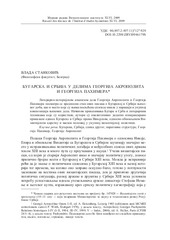Prikaz osnovnih podataka o dokumentu
Bugarska i Srbija u delima Georgija Akropolita i Georgija Pahimera
Bulgaria and Serbia in the historical works of George Akropolites and George Pachymeres
| dc.creator | Stanković, Vlada | |
| dc.date.accessioned | 2021-10-12T10:55:50Z | |
| dc.date.available | 2021-10-12T10:55:50Z | |
| dc.date.issued | 2009 | |
| dc.identifier.issn | 0584-9888 | |
| dc.identifier.uri | http://reff.f.bg.ac.rs/handle/123456789/850 | |
| dc.description.abstract | Literarno-istorijskom analizom dela Georgija Akropolita i Georgija Pahimera posmatra se vrednosni stav ovih pisaca o Bugarskoj i Srbiji njihovog doba kao i mesto koje su njima posvećene epizode imale u naraciji i ukupnoj kompoziciji njihovih dela. Načinom prikazivanja Bugara i Srba i literarnim tehnikama koje su koristili, autori su kvalitativno dodatno iznijansirano prikazali odnose Bugarske i Srbije prema Nikejskom, odnosno obnovljenom Vizantijskom carstvu i njihov položaj u ukupnoj vizantijskoj politici. | sr |
| dc.description.abstract | The paper analyzes the well-known historical works of George Akropolites and George Pachymeres from the viewpoint of their literary composition structure, lexica and narrative techniques used for describing events and personalities from Bulgaria and Serbia. An attempt is made to surpass the 'traditional' methodology and the usually applied standard approach that focuses almost exclusively to the search for the 'strong' historical facts in these literary works par excellence, in that way overlooking their strong literary character, careful expressions, sometimes evident and sometimes more subtle style differences whose purpose was to underline the focal points and the conclusions of the content of the stories - in short, the information and the stories about Bulgaria and Serbia by Akropolites and Pachymeres are analyzed in their entirety, viewed as the integral parts of the complex literary works, and not as isolated episodes, divided from the rest of the narrative. The ways in which George Akropolites depicted and described deaths of the Bulgarian rulers were studied as one of the best examples of his conscious endeavors to bring the literary style of his History in accord with his own judgments about the rulers of the neighboring country. Scenes of death, conspicuously frequent in Akropolites' relatively short historical work, play an important role in characterizing personalities, and the same principle which Akropolites uses for judging the Byzantines is applied to the Bulgarians as well: generally positive opinion about somebody's life and achievements is emphasized with a depiction of his death in a positive way (Ivan II Asen), and vice versa, Akropolites' 'villains' receive their horrible deaths as a deserved punishment for their bad deeds (Kalojan's death). On the other hand, Akropolites' scarce information about Serbs is supplemented with his depiction of the Serbian king Uroš (1243-1276), and his stance after the death of John Batatzes from the funerary oration to the same emperor, which has been completely overlooked by the scholars until now. Akropolites confirms that the Empire of Nicaea and king Uroš's Serbia were strongly connected, and that only after the death of the 'mighty' John Batatzes Serbian king allied himself with the ruler of Epiros, despotes Michael II Angelos. More complex in structure, language, narrative techniques and expressions than Akropolites' is without doubt the voluminous History by George Pachymeres. In the context of Pachymeres' depiction of the Bulgarians and Serbs, the chapters that describe Byzantine marital diplomacy regarding Bulgaria and Serbia are studied in details, with the emphasis placed equally on the literary analysis of the corresponding chapters, and on the concordance between the content and style, author's attitudes and expressions used, Pachymeres' intention and the form he had chosen, which all contribute in the end to the better understanding of the historical circumstances, as well. The following chapters of Pachymeres' History, forming the comprehensive narrative segments, were examined in detail: - the description of the marriage of the Bulgarian tsar Constantine Tich with the niece of the emperor Michael VIII (Pachymérès II/ V, 3: 441-445); - the unsuccessful attempt of alliance by marriage between the Serbian prince Milutin and the second daughter of the emperor Michael VIII (Pachymérès II/ V, 6: 453-457); - negotiations for the marriage between now king Milutin and Simonis, young daughter of the emperor Andronikos II, with all the circumstances that followed the complex negotiating process (Pachymérès III/ IX, 30: 299-303 Pachymérès III/ IX, 31: 303-305; Pachymérès IV/ X, 1: 307-309; Pachymérès IV X, 2: 309-313; Pachymérès IV/ X, 3: 313; Pachymérès IV/ X, 4: 313-315 Pachymérès IV/ X, 5: 315; Pachymérès IV/ X, 8: 319-321; Pachymérès IV/ X, 9 321-327). | en |
| dc.publisher | Srpska akademija nauka i umetnosti SANU - Vizantološki institut, Beograd | |
| dc.relation | info:eu-repo/grantAgreement/MESTD/MPN2006-2010/147028/RS// | |
| dc.rights | openAccess | |
| dc.rights.uri | https://creativecommons.org/licenses/by-nc/4.0/ | |
| dc.source | Zbornik radova Vizantološkog instituta | |
| dc.subject | Srbija | sr |
| dc.subject | slika drugog | sr |
| dc.subject | narativne strukture | sr |
| dc.subject | Georgije Pahimer | sr |
| dc.subject | Georgije Akropolit | sr |
| dc.subject | Bugarska | sr |
| dc.title | Bugarska i Srbija u delima Georgija Akropolita i Georgija Pahimera | sr |
| dc.title | Bulgaria and Serbia in the historical works of George Akropolites and George Pachymeres | en |
| dc.type | article | |
| dc.rights.license | BY-NC | |
| dc.citation.epage | 200 | |
| dc.citation.issue | 46 | |
| dc.citation.other | (46): 179-200 | |
| dc.citation.rank | M24 | |
| dc.citation.spage | 179 | |
| dc.identifier.fulltext | http://reff.f.bg.ac.rs/bitstream/id/2379/847.pdf | |
| dc.identifier.rcub | https://hdl.handle.net/21.15107/rcub_reff_850 | |
| dc.type.version | publishedVersion |

